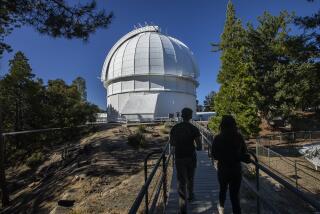Seeing Stars
- Share via
When something new appears overhead, such as the Hale-Bopp comet streaking through the northeastern night sky, we begin to do something that urbanites don’t normally do: We look up.
And if the air is clear enough and the night is dark enough, many of us marvel once again at the sight of our glowing celestial neighbors. A few of us, inspired, head out to the local store to buy ourselves our own backyard Hubble.
But mention off-brand telescopes in the sub-$300 range and the cognoscenti of the celestial optics biz start to grind their teeth in unison. The first piece of advice they give rookie Galileos: Don’t buy a mass-produced, generically promoted, budget-priced precision instrument that isn’t.
“There are no such things as good, cheap telescopes,” said Alan MacRobert, the associate editor of Sky and Telescope magazine. “The so-called department store telescopes that are mass-marketed to the public are generally considered by people who use telescopes to be junk, to be toys.”
It is usually best, say astronomers, to buy any telescope from a specialty retailer or through mail-order from one of a handful of quality manufacturers. Also, reliable leads can be found in astronomy magazines and through astronomy clubs.
Don’t go goggle-eyed over magnification claims, said Jerry Keegan, the sales manager of Scope City in Costa Mesa. Small telescopes of any type that are advertised with 400 to 600 power, he said, may sound impressive, but in telescopes, as in life, power corrupts. It is not magnification, but light-gathering capability that makes for the best celestial viewing.
Most objects in the sky are fairly faint and magnification power won’t make them appear any brighter. Also, an eyepiece that greatly boosts the power of a small telescope will result in a lack of image resolution. “The higher the magnification, the worse things usually look,” said Steve Maran, a spokesman for the American Astronomical Society. “That sounds exactly wrong, but that’s the way it works.”
A general rule of thumb holds that the practical maximum magnification limit is about 50X for each inch of aperture.
There are two main types of mounts: the altazimuth (altitude-azimuth) or Dobsonian mount that allows simple vertical and horizontal motion, and the equatorial mount, which allows the telescope to track an object through a predetermined arc in the sky.
There are three main categories of telescopes, each with advantages and liabilities:
Refractors--These are the spyglass-style telescopes that are the direct descendants of Galileo’s original, and are often a first choice for rookies. They are rugged, portable, and offer good power and contrast, particularly if you’re viewing the heavens from an urban environment. According to Dickinson, good models can cost between $500 and $2,000. The refractor’s light-gathering capability, however, is less than that of the reflector.
Newtonian reflectors--The least expensive type for its aperture size, reflectors also have the advantage of great light-gathering capability and have earned a telling nickname: “light buckets.” Reflectors consist of a tube with a parabolic mirror at one end. The light and images are reflected back from that mirror the length of the tube to a second mirror that concentrates the image and reflects it sideways to the eyepiece.
A 6-inch Newtonian reflector with a Dobsonian (azimuth) mount “is probably the most telescope for the money for someone getting started,” said MacRobert. It would go for about $400 to $500.
Reflectors, however, can be used effectively only at night because of their great light-gathering capability, said Keegan. Also, he said, they can be jostled out of alignment fairly easily. Finally, said MacRobert, they can be unwieldy in larger sizes.
Compound telescopes--So called because they combine many of the best features of refractors and Newtonian reflectors, these instruments also have the advantage of portability. The most common type, the Schmidt-Cassegrain, “has a concave main mirror like the Newtonian, but a lens at the top of the tube performs the triple function of correcting for optical aberrations, sealing the tube from dust and other airborne pollutants and supporting a second mirror that reflects the concentrated light back through a hole in the main mirror,” wrote Terence Dickinson in “NightWatch” (Firefly Books, 1996). “The light is finally focused at the rear of the telescope.”
The Schmidt-Cassegrain benefits from what are known as “folded optics,” said Keegan. The light, he said, is reflected back and forth in the tube three times before it reaches the eyepiece, enabling the tube to be made much smaller than a reflector. Some models are compact enough to sit on the corner of a desk.
Compound telescopes are the most expensive type (8-inch Schmidt-Cassegrains can cost between $1,500 and $4,000), but they are considered “the Rolls-Royces of telescopes,” said David Levy, an amateur astronomer from Arizona who has discovered 21 comets. “Some are more sophisticated than most professional astronomers use, but I wouldn’t recommend one for a beginner.”
In fact, say astronomers, the first step in stargazing is to learn the layout of the heavens with a star map. And the first optical instrument that one would point skyward might be a pair of binoculars rather than a telescope. Binoculars with 7X50 power, said Maran, are ideal.
(BEGIN TEXT OF INFOBOX / INFOGRAPHIC)
Where to Look for the Comet
Comet Hale-Bopp will be in the northwestern evening sky during the last week of March and about the first 10 days of April. It will be visible low in the sky shortly after sunset.
More to Read
Sign up for The Wild
We’ll help you find the best places to hike, bike and run, as well as the perfect silent spots for meditation and yoga.
You may occasionally receive promotional content from the Los Angeles Times.






